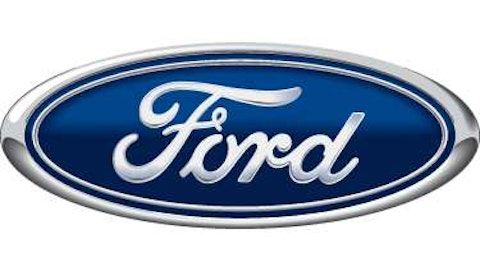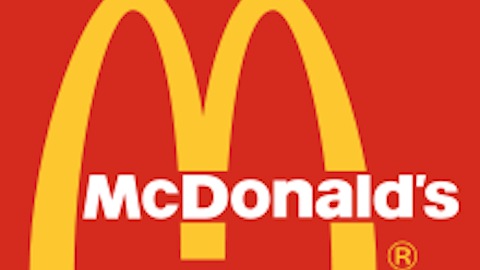McDonald’s Corporation (NYSE:MCD) , the world’s largest fast food chain, recently reported its results for the fourth quarter, beating analysts’ estimates. Profit rose very slightly from $1.38 billion in 2011 to $1.4 billion in 2012. Quarterly earnings per share rose to $1.38 as net margins improved slightly on increased non-U.S. margins. However, sales in the Japanese and European markets were soft, as would be expected with both areas in recession. Global comparable sales were essentially flat at +0.1%, which is statistical noise.

Comps in the United States for the quarter rose by just 0.3% due to competition and economic pressures while operating income was flat overall, not a source of margin increase. It was in Europe and APMEA (Asia-Pacific, Middle East, Africa) where margins improved, though comps were off. Income in the European market went up by 5%, with a major contribution coming from the UK and Russia though sales fell by 0.6%. APMEA comps declined by 1.7%, but operating income remained fairly flat, a net increase in margins.
So, in essence, outside of the U.S. McDonald’s still retains some pricing leverage for even foreign currency translation was a negative driver on EPS by $0.01. Excluding the foreign currency losses, EPS actually increased by 5% from last year.
Although McDonald’s managed to eke out some gains, this was a weak report and management concurred, presenting a cautious outlook for 2013. According to the company’s CEO Donald Thompson, the economy is extremely volatile, consumer sentiment is not encouraging – the big drop in the Consumer Reports Index points to that – and its rivals are ramping up the competition; thus spending and growth of the restaurant industry is likely to continue with the same trends in the coming year. Sales for January are expected to fall compared to the same period last year versus a 6.7% increase last January.
McDonald’s faces tough competition from Burger King Worldwide Inc (NYSE:BKW) and Yum! Brands, Inc. (NYSE:YUM)’s Taco Bell over new food items and the dollar menu. Burger King has introduced molten fudge bites, sundaes, improved versions of its Italian chicken sandwich and cheesy tots. Similarly Taco Bell’s value items for $0.99 are being heavily advertised, continuing to focus on the magic price point even as portion size and food quality decline. This is something McDonald’s has in mind, and it is planning on introducing stronger menu items this year. It has started off by testing chicken wings for its outlets in Chicago. Also, McDonald’s is planning to introduce Fish McBites for its customers in the US, along with beef sandwiches, chicken entrees and breakfast menu items in an attempt to boost sales in its second biggest market.
| McDonalds | Yum Brands | Burger King | |
| Market Cap | $95.3 Bln | $29.02 Bln | $6.24 Bln |
| Stock 6M | 5.91% | -3.23% | 16.17% |
| P/E | 17.67 | 18.94 | 0.73 |
| EPS | 5.36 | 3.4 | 24.46 |
| Yield | 3.30% | 2.10% | 0.90% |
| Beta | 0.31 | 0.68 | N/A |
| ROE | 38.66% | 73.68% | 7.20% |
In the last six months, the much smaller Burger King has outperformed its bigger rivals and the SPDR S&P 500 ETF, which is up by 8.22% in the corresponding period. McDonalds and Yum Brands have a dominant presence all around the world. Both are increasingly focusing on the emerging markets, particularly China, for their future growth.
In China, McDonald’s has its hands full after the ‘tainted chicken scare.’ In the U.K. Burger King will have to fend off the PR nightmare that is finding horse meat mixed in with the beef used in its patties. Although McDonald’s and Yum Brands have been cleared of these charges, the American food chains are still facing negative reviews from both the media and the general public, and this could cause a temporary dip in revenues. Nonetheless, China remains an integral part of McDonald’s growth strategy, and the fact of the matter is McDonald’s hasn’t done anything wrong. Things like this always feel politically motivated. The U.S. and China have been playing tit-for-tat in trade war and tariff spat rhetoric for the past couple of years as both engage in predatory monetary policy.
The company aims to spend $3.2 billion on opening 1,400 to 1,600 new stores around the world. Out of this, 700 new outlets will be opened in China by the end of the year, taking its store count to 2,000 in the country. Moreover, there are rumors floating around here that McDonald’s will be opening up its first store in Vietnam later this year. The U.S. and European markets will be marked by low growth and shallow profits. This year’s cattle herds are the smallest that they have been in the U.S. in nearly 60 years as cattle futures have hit an all-time high on the COMEX at $1.33 per pound recently. This, along with the rising price of oil and other commodities, including grains, is going to weigh heavily on all of the QSR’s bottom lines in 2013. The Federal Reserve is inviting price inflation in the U.S. and conditions are ripe for them to get their wish. The effects of that inflation will be felt first in commodity prices.
I would be wary of all of the QSR stocks right now, believing they are fully-valued, especially in the face of higher corn, soy and beef prices, which will have a knock-on effect into chicken prices. Wheat price gains should be tamer this year with increased exports out of countries like India, which makes Domino’s Pizza, Inc. (NYSE:DPZ), a company I’ve had an open long-call on for more than a year, expansion plans across Asia interesting. India is a particular focus for Domino’s right now.
That said, however, McDonald’s stock just gave a long-term buy signal and its strong expansion plans, unmistakable brand and excellent supply chain management put it in a very good position to succeed in emerging markets like Southeast Asia over the next few years. Moreover, in a weak U.S. dollar environment, foreign exchange gains should offset some food-related costs.
The article McDonald’s Churns Higher on Improved Margins Abroad originally appeared on Fool.com and is written by Peter Pham.
Copyright © 1995 – 2013 The Motley Fool, LLC. All rights reserved. The Motley Fool has a disclosure policy.




